1. What was the initial scientifically valid cosmological model of the universe proposed by Aristotle?
2. Can you explain the new cosmological model?
3. Who is responsible for proposing this new cosmological model?
4. In which scientific field does cosmology fall under?
6. How do scientists test theoretical models that describe the overall properties of the Universe?
7. Who were the pioneers in developing the first cosmological models?
8. Among these disciplines, which one is not considered fundamental to the study of cosmology?
9. Which scientist is credited with creating the general theory of relativity?
Since ancient times, humans have pondered their position in the world, the surrounding environment, and its designation. The universe encompasses the stars and planets, which are integral components of our existence. Over time, various knowledge about these entities, theories regarding the world’s origin, physical assumptions, mathematical principles, and philosophical concepts were amalgamated into a single discipline known as cosmology. But what exactly is modern cosmology and what forms its foundation?
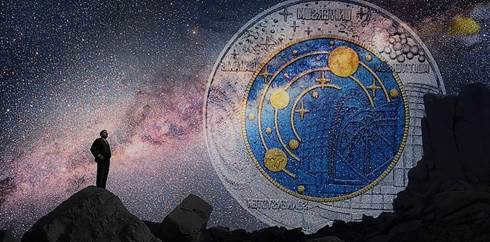
The Development of Modern Cosmology
When discussing the era of significant advancements in the field of cosmology, it is essential to mention the 20th century. During this time, Albert Einstein proposed multiple theories regarding the universe. He later proved these theories using the gravitational field equation. These studies were closely related to the general theory of relativity, which gained significant attention during that period.
In his initial paper titled “Cosmological Considerations to the General Theory of Relativity,” Einstein derived three assumptions. These assumptions considered the universe to be homogeneous, stationary, and isotropic.
First and foremost, in order to validate his claims, he utilized the equations for gravitational field – he introduced an additional variable. Eventually, a resolution to the problem was obtained. This particular resolution served as evidence for his hypotheses.
It transpires that the Universe possesses specific boundaries and exhibits positive curvature.
Nevertheless, the investigation did not conclude there. Alexander Alexandrovich Friedman (1922) continued his exploration of the equation. He proposed an alternative, nonstationary solution. According to his viewpoint, the Universe was expanding from an initial singularity.
By the way, Friedman’s assumption was proven true with Edwin Hubble’s discovery of cosmological redshift. These breakthroughs led to the development of the Big Bang theory, which remains significant in contemporary cosmology. It is important to note that the foundation of modern cosmology lies in the discoveries of the 20th century, despite the fact that scientific study began much earlier.
In actuality, modern cosmology has determined the age of the universe to be 13.8 billion years.
The currently accepted classification of time periods
Currently, the earliest time period is known as the Planckian era. This era is significant because it marks the emergence of the earliest theoretical ideas. According to available data, during this era, gravitational interaction became distinct and separate from the other fundamental forces.
The following time period is identified in scientific literature as the emergence of quark particles and the separation of interaction forces. Since this period occurred at a later point in time, scientists have been able to obtain a relatively detailed description of the processes that took place.
The final interval is characterized by the formation of celestial bodies such as stars, galaxies, and the solar system as a whole. It should be noted that this era is still considered to be ongoing and incomplete.
It should be pointed out that the era of recombination holds great significance in the development of the Universe. During this period, the Universe transitioned into a state of transparency towards radiation. As a result, it became observable, such as in the form of a residual background. This experiment served as a definitive validation of the various models concerning the existence of the universe.
With the advancement of modern science, cosmology has undergone significant changes.
Before delving into the groundbreaking advancements in cosmology, it is important to discuss earlier stages of research.
First and foremost, it is crucial to acknowledge the contributions of Nicolaus Copernicus during the 15th century. In his works, he synthesized the accumulated knowledge from previous periods, which included the works of Samosky, Leonardo da Vinci, Heraclitus, and Cuso. The central idea proposed was that the solar system is inertial, with the sun positioned at the center around which the planets, including Earth, orbit.
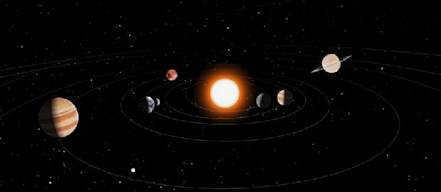
Kepler made a significant contribution to the field of cosmology, establishing three major theories which later served as the foundation for Newton’s laws of dynamics.
The 20th century witnessed several other important discoveries in cosmology. Einstein, Friedman, and Hubble were among the first to share their findings. Additionally, Fritz Zwicky proposed the existence of dark matter, a substance that does not interact with electromagnetic radiation but has gravitational influence.
Other notable figures in cosmology include Gamow, who developed the theory of the hot Universe, and Penzias and Wilson, who discovered isotropic interference in the radio range.
Summarizing, we can state that there is a strong connection between physical laws and cosmology. Numerous theories and their evidence have been successfully explained from a physical perspective.
The primary conceptual concepts of cosmology
Actually, there are multiple theories about the origin of the universe. One of them can be referred to as theological, as described in the Bible. According to the scriptures, the universe remained hidden and invisible to others until a certain point, unattainable to the eyes of other people.
However, there were other assumptions that were made based on scientific considerations. One of these assumptions came from Einstein, who believed that the universe was stationary. However, this idea was later disproven by Friedman, who showed that the universe was actually expanding and contracting due to certain movements. Additionally, Hubble’s research provided more accurate information about the distances between galaxies, which led to the development of the Big Bang theory.
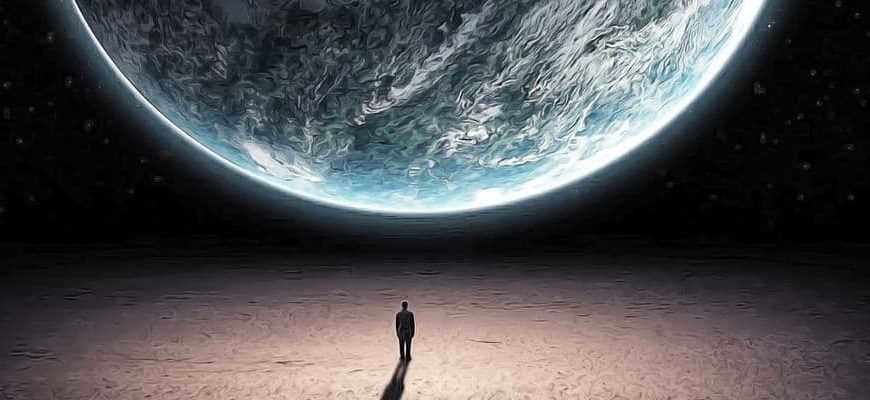
The field of cosmology, a branch of astronomy, is known to be particularly mind-boggling due to the complex subjects it explores. It grapples with profound questions that continue to elude clear answers. As the renowned scientist Carl Sagan once noted, these enigmas were once the exclusive domain of ancient myths and religious texts….
Cosmology is filled with enigmas
The field of cosmology is dedicated to investigating the origins and evolution of the universe, from the moment of the Big Bang until the present day. It also endeavors to explore the distant future. Cosmologists undertake the daunting task of studying the universe on a grand scale, grappling with profound questions about its fate and origin.
Cosmologists delve into a wide range of intricate and multifaceted concepts, including string theory, dark energy, and dark matter. They even entertain the notion that we may exist within a Multiverse, one of many universes comprising it. Unlike other branches of astronomy, cosmology does not focus on any specific component of the universe, such as stars or galaxies. Rather, it examines the universe as a whole.
Cosmologists, who have dedicated their lives to the study of the universe, are continuously confronted with a multitude of profound inquiries. What lies ahead for our universe in the future? What existed prior to the occurrence of the Big Bang? What is the precise form of the universe? Pondering over these subjects has the capability to induce a whirlwind of thoughts within the mind.🤓
Evolution of Cosmology
The understanding of the universe has undergone significant transformations throughout history. Initially, ancient astronomers believed that the Earth held a central position in the cosmos, with all celestial bodies orbiting around it. However, in the early 16th century, Nicolaus Copernicus challenged this notion by proposing that the Earth and other planets actually revolve around the Sun. This revolutionary idea sparked a paradigm shift in our perception of the cosmos.
In the 17th century, Isaac Newton’s groundbreaking work on gravitational forces shed further light on the mechanics of celestial bodies. Then, at the turn of the 20th century, Albert Einstein introduced the concept of unifying space and time through his general theory of relativity. This monumental theory has shaped our current understanding of the cosmos.
In the early 20th century, scientists pondered whether the Milky Way encompassed the entire universe or if it was merely a minuscule fragment of it.
Edwin Hubble was the trailblazer in calculating the distance to the Andromeda galaxy, which ultimately revealed that it existed outside the confines of the Milky Way.
Consequently, it dawned on humanity that our Galaxy was nothing more than a tiny speck in the vast expanse of the Universe. Using the principles of general relativity, Edwin Hubble managed to measure the distances to other galaxies. He was astounded to discover that nearly all of them were moving away from us. This groundbreaking revelation solidified the understanding that the universe is not stationary, but instead, it is in a perpetual state of expansion.
Frequently Asked Questions
Cosmology, despite its complexity, has already managed to provide answers to some fundamental questions. Although these answers may not be comprehensive, they still offer valuable insights.
One of the most commonly asked questions is: Where did the Big Bang occur? The answer to this question is quite intricate. The Big Bang did not occur at a specific location in the Universe; it happened simultaneously everywhere. This is because the Big Bang marked the emergence of both space and time. There is no specific point in the Universe that we can pinpoint and say, “This is where the Big Bang occurred!”
However, if all galaxies are in motion away from us, it raises the question – does this imply that we occupy the central position in the Universe? The response to that query is rather straightforward. If we were situated in a different galaxy, we would observe the same phenomenon. In a sense, it’s akin to envisioning the universe as an immense balloon. If you were to designate a few points on its surface and then begin inflating it, all of the designated points would uniformly recede from one another. Despite this, none of them would occupy the hypothetical center of the balloon’s surface.
The most important questions in the field of cosmology
However, the age and future of the universe are perhaps the most perplexing questions in cosmology. According to data from the Planck Space Observatory, scientists have determined that the universe is approximately 13.8 billion years old, with a margin of error of plus or minus 100 million years. The Planck Observatory made these calculations by examining small temperature differences in the background radiation.
But what lies ahead for our universe? Will it continue to exist indefinitely, or is there an end in sight? Scientists believe that the answer to this question depends on various factors, such as the overall density of matter in space.
Astronomers have already calculated this “critical density” value.
It has been discovered that in the event that the universe’s density surpasses the critical level, the expansion of the universe will decelerate. Ultimately, it will reverse and the universe will collapse, only to explode once more. Conversely, if the density is below the critical point, the Universe will continue expanding indefinitely and will eventually encounter a phenomenon known as “heat death”.
Presently, this hypothesis holds the highest level of popularity.
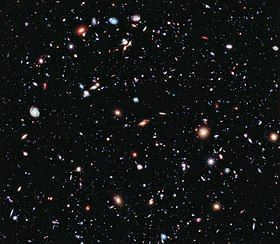
The Hubble Extreme Deep Field (XDF) was finalized in September 2012 and captures images of the farthest galaxies ever documented. Apart from a few stars in the foreground (distinguished by their distinct diffraction bursts), every point in the image represents a distinct galaxy, some of which date back 13.2 billion years. ; experts believe that the visible Universe contains over 2 trillion galaxies.
Cosmology, which comes from the Greek words “kosmos” meaning “world” and “logia” meaning “study,” is a field of study within astronomy that focuses on understanding the origins and development of the universe, starting from the Big Bang and continuing to the present and beyond. It involves the scientific investigation of how the universe came to be, how it has evolved over time, and what its future may hold. Physical cosmology specifically examines the origins of the universe, its structure on a large scale, its dynamics, its ultimate destiny, and the fundamental laws of science that govern it.
The term “cosmology” was first used in English in 1656 by Thomas Blount in his Glossography. It was later used in Latin by the German philosopher Christian Wolff in his work titled Cosmologia Generalis in 1731.
In addition to scientific cosmology, there is also religious and mythological cosmology, which is based on beliefs found in mythological, religious, and esoteric texts. These cosmologies often include creation myths and ideas about the end of the world.
Physical cosmology is an area of study that attracts the attention of various professionals, including astronomers, physicists, metaphysicians, philosophers of physics, and philosophers of space and time. This interdisciplinary nature of the field means that theories in physical cosmology may incorporate both scientific and non-scientific assumptions, some of which cannot be empirically tested. Unlike astronomy, which focuses on individual celestial objects, cosmology examines the universe as a whole.
One prominent theory in modern physical cosmology is the Big Bang theory, which aims to reconcile observational astronomy with particle physics. Specifically, the widely accepted Lambda-CDM model parameterizes the Big Bang using concepts like dark matter and dark energy.
The field of cosmology has been described by theoretical astrophysicist David N. Spergel as a “historical science” because, when we observe the universe, we are essentially looking back in time. This is a result of the finite speed of light, which means that the light we see from distant objects has taken a significant amount of time to reach us.
- 1. Areas of study
- 2. Notable discoveries
- 2.1. Physical cosmology
- 2.2. Religious or mythological cosmology
- 2.3. Philosophical cosmology
Fields of Study
Physics and astrophysics have played a significant role in shaping our understanding of the universe through scientific observation and experimentation. The study of physical cosmology has been heavily influenced by mathematics and observation, allowing us to analyze the entire universe. It is widely accepted that the universe originated from the Big Bang, followed by rapid cosmic inflation, which led to the expansion of space and the birth of our universe approximately 13.799 ± 0.021 billion years ago. Cosmogony focuses on the origins of the universe, while cosmography explores the various features of the universe.
In Diderot’s Encyclopedia, cosmology is further divided into different subdisciplines. Uranology, also known as the science of the heavens, examines celestial bodies and phenomena. Aerology, the science of air, studies the properties and behavior of the Earth’s atmosphere. Geology, on the other hand, is concerned with the study of continents and their formations. Lastly, hydrology delves into the science of waters, including the study of oceans, rivers, and other bodies of water.
Metaphysical cosmology was also characterized as the positioning of humans within the universe in relation to all other entities. An instance of this can be seen in Marcus Aurelius’ reflection on the role of man in this dynamic: “One who lacks knowledge of the nature of the world is ignorant of their place within it, and one who lacks understanding of the purpose for which the world exists is ignorant of their own identity and the true nature of the universe.”
Discoveries
New Findings
New Findings is a field of physics and astrophysics that focuses on exploring the origins and development of the universe. It also involves studying the characteristics of the universe on a large scale. Initially, it was referred to as “celestial mechanics,” which delved into the study of celestial bodies. Ancient Greek philosophers such as Aristarchus of Samos, Aristotle, and Ptolemy put forth various cosmological theories. Ptolemy’s geocentric model remained widely accepted until the 16th century when Nicolaus Copernicus, followed by Johannes Kepler and Galileo Galilei, introduced the heliocentric model. This groundbreaking shift in perspective is a well-known example of a knowledge gap in the realm of physical cosmology.
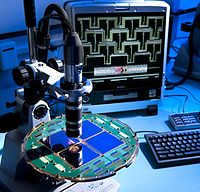
The BICEP2 Radio Telescope could potentially detect evidence of gravitational waves in the early universe through microscopic examination of its focal plane.
In 1687, Isaac Newton published his Principia Mathematica, which introduced the law of universal gravitation. This groundbreaking work explained Kepler’s laws and resolved anomalies caused by gravitational interactions between planets. Newton’s cosmology was distinct from previous theories because of the Copernican principle, which stated that the same physical laws apply to celestial bodies as they do to objects on Earth. This principle was a significant advancement in the field of physical cosmology.
The origins of modern scientific cosmology can be traced back to 1917 when Albert Einstein published his latest modification of the general theory of relativity in an article titled “Cosmological Considerations of the General Theory of Relativity.” This groundbreaking work, however, was not widely available outside of Germany until after World War I. Einstein’s theory paved the way for cosmogonists like Willem de Sitter, Karl Schwarzschild, and Arthur Eddington to explore the astronomical implications of the general theory of relativity, expanding astronomers’ ability to study distant celestial objects. This new understanding challenged the prevailing belief that the universe was static and unchanging. In 1922, Alexander Friedmann proposed the concept of an expanding universe with moving matter. During this same period, known as the Great Debate (1917-1922), early cosmologists such as Heber Curtis and Ernst Epic observed and determined that certain nebulae visible through telescopes were actually separate galaxies located far beyond our own.
Alongside this dynamic approach to cosmology, a long-standing discussion about the structure of the universe was approaching its peak. Harlow Shapley, an astronomer from Mount Wilson, supported a model of the universe that consisted solely of the Milky Way star system. On the other hand, Heber D. Curtis argued that spiral nebulae were star systems in their own right, serving as island universes. This difference in perspective came to a head with the organization of the Great Debate on April 26, 1920, during a meeting of the U.S. National Academy of Sciences in Washington, D.C. The controversy was ultimately settled when Edwin Hubble made the groundbreaking discovery of variable Cepheids in the Andromeda Galaxy in 1923 and 1924. By measuring their distances, it was determined that spiral nebulae extended far beyond the boundaries of the Milky Way. Path.
Further investigation of the cosmos examined the possibility that the cosmological constant, initially introduced by Einstein in his 1917 publication, might result in an expanding universe, contingent upon its specific value… As an illustration, the conception of the Big Bang model was proposed by the Belgian clergyman Georges Lemaître in 1927, a notion subsequently validated by Edwin Hubble’s identification of redshift in 1929, followed by Arno Penzias and Robert Woodrow Wilson’s detection of cosmic microwave background radiation in 1964. These breakthroughs marked the initial strides in discrediting various alternative cosmologies.
Since approximately 1990, numerous remarkable breakthroughs in observational cosmology have completely revolutionized the field, transforming it from a predominantly speculative discipline into a predictive one with remarkable concordance between theory and observation. These breakthroughs encompass the detection and analysis of the cosmic microwave background radiation by the COBE, WMAP, and Planck satellites, as well as extensive redshift surveys of newly discovered large galaxies like 2dfGRS and SDSS, and the observation of distant supernovae and gravitational lensing. Remarkably, these observations have consistently aligned with the predictions made by cosmic inflation theory, modified Big Bang theory, and a specific variant known as the Lambda-CDM model. As a result of these groundbreaking discoveries, many have dubbed this era as the “golden age of cosmology”.
Gravitational waves were discovered by astronomers at the Harvard-Smithsonian Center for Astrophysics on March 17, 2014, providing strong evidence for inflation and the Big Bang. However, on June 19, 2014, it was reported that the confidence in confirming the results of cosmic inflation had decreased.
Astronomers reported at the Planck 2014 meeting in Ferrara, Italy on December 1, 2014, that the universe is 13.8 billion years old and is composed of 4.9% atomic matter, 26.6% dark matter, and 68.5% dark energy.
Religious or mythological cosmology
Religious or mythological cosmology refers to a system of beliefs that is rooted in mythological, religious, and esoteric texts and traditions. It encompasses ideas about the origins and ultimate destiny of the universe.
Philosophical cosmology
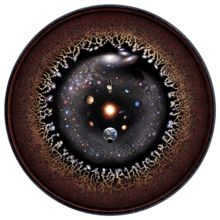
An illustration of the observable universe displayed on a logarithmic scale.
Cosmology deals with the entirety of space, time, and all phenomena in the world. Throughout history, it has had a wide-ranging focus and often relied on religious beliefs. In contemporary usage, metaphysical cosmology explores questions about the universe that go beyond the realm of science. It differs from religious cosmology in that it approaches these inquiries using philosophical methods like dialectics. Modern metaphysical cosmology seeks to provide answers to questions such as:
- What is the origin of the universe? What is its initial cause? Is its existence necessary? (See monism, pantheism, emanationism, and creationism)
- What are the fundamental material constituents of the universe? (See mechanism, dynamism, hylomorphism, atomism)
- What is the fundamental cause for the presence of the universe? Is there a design to the cosmos? (See teleology )
- Does the presence of awareness serve a purpose? How do we ascertain our understanding of the entirety of the cosmos? Does cosmological reasoning uncover metaphysical realities? (see epistemology )
Historical study of the universe
| Hindu cosmology | Rigveda (c. 1700-1100 BCE) | Cyclic or fluctuating, Infinite in time | Primary matter remains manifested for 311.04 trillion years and unmanifested for equal duration. The universe remains manifest for 4.32 billion years and unmanifest for equal length. Countless universes exist t at the same time. These cycles have been and will continue forever, driven by desire. |
| Jain cosmology | Jain agamas (written around 500 AD according to the teachings of Mahavira 599-527 BC) | Cyclical or fluctuating, eternal and finite | Jain cosmology views the loka, or universe, as an uncreated entity existing from infinity, the shape of the universe is similar to a human being standing with legs spread apart and a hand on his waist. This universe, according to Jainism, is wide at the top, narrow in the middle and becomes wide again at the bottom. |
| Babylonian cosmology | Babylonian literature (c. 3000 BCE) | A flat Earth floating in endless “waters of chaos” | Earth and Heaven form a unity in the infinite “waters of chaos”; the Earth is flat and round, and a solid dome (“firmament”) protects the outer “chaos” – the ocean. |
| Eleatic cosmology | Parmenides (c. 515 BC). | Finite and spherical in extent | The universe is unchanging, homogeneous, perfect, necessary, timeless, and neither generated nor spoiled. Emptiness is impossible. Plurality and change are products of epistemic ignorance, generated by sensory experience. Temporal and spatial limitations are arbitrary and refer to the Parmenidean whole. |
| Biblical cosmology | Narrative of the creation of the world | Earth floating in the infinite “waters of chaos” | Earth and Heaven form a whole in infinite “waters of chaos”; the “firmament” holds the outer “chaos”-the ocean. |
| Atomistic universe | Anaxagoras (500-428 BC) and later Epicurus. | Infinite extension | The universe contains only two things: an infinite number of tiny seeds ( atoms ) and an infinite void. All atoms are composed of the same substance but differ in size and shape. Objects form from clusters of atoms and disintegrate into atoms again. Includes Leucippus’ principle of causality : ‘nothing happens by chance; everything happens by reason and necessity’. The universe is not ruled by gods. |
| Pythagorean universe | Philolaus (d. 390 BC). | The existence of a “Central Fire” at the center of the universe. | There is a central fire at the center of the universe around which the Earth, Sun, Moon, and planets revolve evenly. The Sun revolves around the central fire once a year, the stars are motionless. The Earth in its motion maintains the same hidden face to the central fire, so it is never seen. The first known non-geocentric model of the universe. |
| De Mundo | Pseudo-Aristotle (d. 250 BC or between 350 and 200 BC) | The universe, then, is a system consisting of heaven and earth and the elements they contain. | There are “five elements arranged in spheres in five regions, the smaller in each case being surrounded by the larger, namely, earth surrounded by water, water by air, air by fire, and fire by ether, constitute the whole universe.” |
| The Stoic universe | Stoics (300 B.C. – 200 A.D.) | An island universe | The cosmos is finite and surrounded by an infinite void. It is in constant motion, pulsing in size and subject to periodic upheavals and conflagrations. |
| Aristotelian universe | Aristotle (384-322 BC). | Geocentric, static, stable, finite size, infinite time | Spherical Earth is surrounded by concentric celestial spheres. Universe exists unchanging throughout eternity. Contains a fifth element called ether, which was added to the four classical elements. |
| Aristarchian universe | Aristarchus (ca. 280 B.C.) | Heliocentric | The Earth revolves on its axis daily and orbits the Sun in a circular orbit each year. The sphere of fixed stars is centered around the Sun. |
| Ptolemy’s model | Ptolemy (2nd century AD) | Geocentric (based on the Aristotelian universe) | The universe revolves around a stationary Earth. The planets move in circular epicycles, each with a center that moves in a larger circular orbit (called an eccentric or deflection) around a central point near Earth. The use of equants added another layer of complexity and allowed astronomers to predict the positions of the planets. The most successful model of the universe of all time, based on the longevity criterion. Almagest (The Great System). |
| Aryabhat’s model | Aryabhata (499) | Geocentric or heliocentric | Earth rotates and the planets move in elliptical orbits around the Earth or the Sun; not sure if the model is geocentric or heliocentric because of the planetary orbits given relative to the Earth and Sun. |
| Medieval universe | Medieval philosophers (500-1200) | Finite in time | A universe finite in time and having a beginning is proposed by the Christian philosopher John Philoponus, who argues against the ancient Greek notion of an infinite past. Logical arguments in favor of a finite universe are developed by the early Muslim philosopher Alkind, the Jewish philosopher Saadia Gaon, and the Muslim theologian Algazel. |
| Multiverse cosmology | Fakhr al-Din al-Razi (1149-1209) | Multiverse, multiple worlds and universes | There is an infinite outer space beyond the known world, and God has the power to fill the vacuum with an infinite number of universes. |
| Maraga Models | School of Maragha (1259-1528) | Geocentric | Various modifications of Ptolemy’s model and the Aristotelian universe, including the abandonment of equant and eccentricity in the Maragheh Observatory, and the introduction of the Tusi pair from Al-Tusi. Alternative models were later proposed, including Ibn al-Shatir’s first accurate lunar model, a model rejecting a fixed Earth in favor of Ali Kushu’s rotation of the Earth, and a planetary model incorporating “circular inertia” by Al-Birjandi. |
| The Nilakanthan model | Nilakanta Somayaji (1444-1544) | Geocentric and heliocentric | Universe in which the planets revolve around the Sun, which revolves around the Earth; similar to the later system of Tychon |
| Copernican universe | Nicolaus Copernicus (1473-1543) | Heliocentric with circular planetary orbits | First described in De revolutionibus orbium coelestium. |
| Tychonic system | Tycho Brahe (1546-1601) | Geocentric and heliocentric | A universe in which the planets revolve around the Sun and the Sun orbits the Earth, similar to the earlier Nilacanthan model. |
| Bruno’s cosmology | Giordano Bruno (1548-1600) | Infinite extent, infinite time, homogeneous, isotropic, non-hierarchical | Rejects the idea of a hierarchical universe. The Earth and Sun have no special properties compared to other celestial bodies. The void between the stars is filled with ether, and matter is composed of the same four elements (water, earth, fire, and air) and is atomistic, animistic, and intelligent. |
| Keplerian | Johannes Kepler (1571-1630) | Heliocentric with elliptical planetary orbits | Kepler’s discoveries combining math and physics laid the foundation for our current conception of the solar system, but distant stars were still viewed as objects in a thin fixed celestial sphere. |
| Static Newton | Isaac Newton (1642-1727) | Static (evolving), steady state, infinity | Every particle in the universe attracts every other particle. Matter on large scales is uniformly distributed. Gravitationally balanced but unstable. |
| Descartes’ vortex universe | René Descartes, 17th century | Static (evolving), stable, infinite. | A system of huge swirling whirlpools of etheric or subtle matter produces what we would call gravitational effects. But its vacuum was not empty; all space was filled with matter. |
| A hierarchical universe | Immanuel Kant, Johann Lambert, 18th century. | Static (evolving), steady state, infinity | Matter is grouped into ever larger scales of hierarchy. Matter is infinitely recyclable. |
| Einstein’s universe with a cosmological constant | Albert Einstein, 1917. | Static (nominally). Limited (finite) | “Matter without motion.” Contains uniformly distributed matter. Uniformly curved spherical space; based on the Riemann hypersphere. Curvature is assumed to be equal to Λ. In fact, Λ is equivalent to the repulsive force that opposes gravity. Unstable. |
| De Sitter’s universe | Willem de Sitter, 1917. | Expanding flat space. |
With k = 0 and Λ = 0, we are dealing with the critical density.
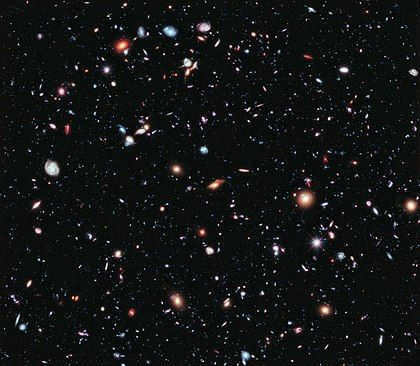
In September 2012, the Hubble Extreme Deep Field (XDF) project was completed, unveiling the farthest galaxy ever captured in a photograph. Apart from a handful of stars in the foreground, identifiable by their distinct diffraction patterns, each point in the image represents a distinct galaxy. Some of these galaxies date back as far as 13.2 billion years, highlighting the vast age of the observable Universe. Scientists estimate that there are over 2 trillion galaxies in total. [1]
Cosmology (derived from the Greek word κόσμος, Cosmos meaning “world” and -λογία, -logia meaning “study”) is a field of astronomy that focuses on the examination of the inception and progression of the universe, starting from the Big Bang until the present time and beyond. It is a scientific exploration of the origins, development, and eventual destiny of the universe. Physical cosmology is the scientific investigation of the genesis of the universe, its vast-scale structures and dynamics, and its ultimate destiny, as well as the scientific principles governing these aspects. [2]
The term cosmology was first introduced in English in 1656 in Thomas Blount’s Glossography, [3] and in 1731, it was translated into Latin by the German philosopher Christian Wolff, in the Cosmologia Generalis. [4]
Religious or mythological cosmology refers to a collection of beliefs that are rooted in ancient texts, religious teachings, and mystical traditions. These beliefs encompass various aspects such as creation myths and theories about the end of the world.
Scientists, such as astronomers and physicists, as well as philosophers, such as metaphysicians, philosophers of physics, and philosophers of space and time, study physical cosmology. Because of the overlap with philosophy, theories in physical cosmology may include both scientific and non-scientific propositions and may rely on untestable assumptions. Unlike astronomy, which focuses on individual celestial objects, cosmology examines the universe as a whole. The Big Bang theory, which aims to integrate observational astronomy and elementary particle physics, dominates modern physical cosmology. Specifically, the standard parameterization of the Big Bang, which incorporates dark matter and dark energy, is known as the Lambda-CDM model.
The field of cosmology, according to David N. Spergel, a theoretical astrophysicist, can be described as a “historical science” because when we observe the cosmos, we are essentially looking back in time due to the finite speed of light. [7]
Fields of Study
Physics and astrophysics have played a crucial role in shaping our understanding of the universe through scientific observation and experimentation. The discipline of physical cosmology has been greatly influenced by mathematical analysis and empirical observations. It is widely accepted that the universe originated from the Big Bang, followed by a period of cosmic inflation, which is believed to have occurred approximately 13.799 ± 0.021 billion years ago. [8] Cosmogony explores the origins of the universe, while cosmography studies its various features.
Diderot’s Encyclopédie Cosmologique categorizes cosmology into different branches: uranology (the study of the heavens), aerology (the study of air), geology (the study of continents), and hydrology (the study of waters). [9]
Metaphysical cosmology also explores the position of humans in the universe in relation to all other entities. This idea is supported by Marcus Aurelius’ observation that our place is determined by this relationship: “Those who are unaware of what the world is, are unaware of where they are, and those who are unaware of the purpose of the world, are unaware of their own identity and the nature of the world.” [10]
Explorations
Unveiling the Secrets of the Universe
Exploring the mysteries of the universe and its origins is the primary focus of physical cosmology, a field that encompasses both physics and astrophysics. This branch of science delves into the study of how the universe came to be and how it has evolved over time. Additionally, it investigates the intricate nature of the universe on a grand scale. Initially, this discipline was referred to as “celestial mechanics,” which concentrated on understanding the celestial bodies. In ancient times, philosophers such as Aristarchus of Samos, Aristotle, and Ptolemy put forth various cosmological theories. Ptolemy’s geocentric model, which placed the Earth at the center of the universe, prevailed until the 16th century. It was not until Nicolaus Copernicus, followed by Johannes Kepler and Galileo Galilei, proposed the heliocentric model that a paradigm shift occurred. This transition from a geocentric to a heliocentric system is a well-known example of the epistemological divide within the realm of physical cosmology.
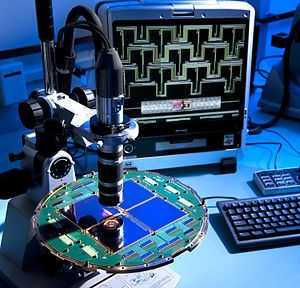
Published in 1687, Principia Mathematica by Isaac Newton was the inaugural account of the law of universal gravitation. It presented the physical explanation for Kepler’s Laws and also resolved inconsistencies in prior models resulting from the gravitational interaction among the planets. A crucial disparity between Newton’s cosmology and preceding ones was the Copernican principle, which asserted that earthly bodies adhere to the same laws of physics as celestial bodies. This constituted a pivotal philosophical advancement in the field of physical cosmology.
- Hubble’s Law·Redshift
- Expansion of the Universe
- The accelerated expansion of the universe
- Related and proper distances
- FLRW metric·Friedmann equations
- Inhomogeneous cosmology
- The Future of the Expanding Universe
- Final destiny of the universe
- Thermal death of the universe
- The Great Tear
- Great Compression
- The Great Bounce
In addition to the dynamic approach to cosmology, a long-standing debate about the structure of the universe was coming to a decisive point. Harlow Shapley, an astronomer at Mount Wilson, advocated for a model of the universe that consisted only of the Milky Way star system. On the other hand, Heber D. Curtis defended the idea that spiral nebulae were star systems in their own right, like island universes. This difference of opinion reached its peak with the organization of the Great Debate on April 26, 1920, during the U.S. meeting of the National Academy of Sciences in Washington, DC. The dispute was finally settled when Edwin Hubble discovered Cepheid variables in the Andromeda Galaxy in 1923 and 1924. These variables allowed for the identification of spiral nebulae well beyond the boundaries of the Milky Way.
The concept of an expanding universe, driven by the cosmological constant introduced by Einstein in his 1917 paper, was further explored in subsequent models. One such model, known as the Big Bang theory, was proposed by Georges Lemaître, a Belgian priest, in 1927. This theory gained support with Edwin Hubble’s discovery of redshift in 1929 and the later discovery of cosmic microwave background radiation by Arno Penzias and Robert Woodrow Wilson in 1964. These groundbreaking findings marked the beginning of the elimination of various alternative cosmological theories.
Gravitational waves were detected by astronomers at the Harvard-Smithsonian Center for Astrophysics on March 17, 2014, providing strong evidence in support of inflation and the Big Bang. [11] [12] [13] However, on June 19, 2014, there was a decrease in confidence regarding the confirmation of cosmic inflation. [15] [16] [17]
During the Planck 2014 meeting in Ferrara, Italy on December 1, 2014, astronomers reported that the age of the universe is 13.8 billion years and it consists of 4.9% atomic matter, 26.6% dark matter, and 68.5% dark energy. [18]
Religion and Mythology in the Study of the Universe
Religion and mythology have long played a significant role in shaping our understanding of the universe. The beliefs and stories found in mythological, religious, and esoteric texts provide us with a unique perspective on the creation and ultimate fate of the cosmos.
The Exploration of Existence through Philosophy
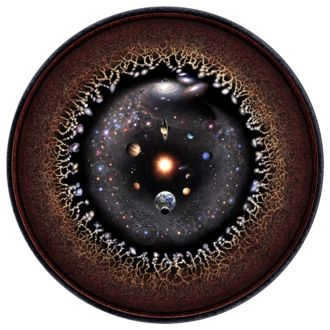
Cosmology is the study of the entirety of space, time, and all phenomena. Throughout history, it has had a wide-ranging scope and often had religious foundations. [19] In modern times, metaphysical cosmology explores questions about the universe that are beyond the realm of science. It diverges from religious cosmology by utilizing philosophical approaches like dialectics to address these inquiries. Contemporary metaphysical cosmology seeks to provide answers to questions such as: [11] [20]
- What is the origin of the universe? What caused its inception? Is its existence necessary? (consider monism, pantheism, emanationism, and creationism)
- What are the fundamental material constituents of the universe? (consider mechanism, dynamism, hylomorphism, atomism)
- What is the fundamental cause for the presence of the universe? Does the cosmos serve a purpose? (refer to teleology)
- Does the presence of awareness serve a purpose? How do we ascertain our knowledge about the entire cosmos? Does cosmological reasoning uncover metaphysical truths? (refer to epistemology)
This article requires more citations to verify its information. Please assist in improving this article by adding citations from reputable sources. Content that is not sourced may be subject to scrutiny and removal.
Find sources: "Cosmology" – News · newspapers · books · scientist · JSTOR ( January 2016 ) (Learn how and when to delete this message template)
| Hindu cosmology | Rigveda (c. 1700-1100 B.C.) | Cyclic or oscillating, Infinite in time | Primary matter remains manifested for 311.04 trillion years and unmanifested for an equal length. The universe remains manifested for 4.32 billion years and unmanifested for an equal length. Countless universes exist simultaneously. These cycles have been and will continue forever, driven by desire. |
| Jain cosmology | Jain Agamas (written around 500 AD according to the teachings of Mahavir 599-527 BC) | Cyclical or fluctuating, eternal and finite | Jain cosmology considers Loka, or universe, as an uncreated entity existing from infinity, the form of the universe is like a human being standing with legs spread apart and resting on the waist. This universe, according to Jainism, is wide at the top, narrow in the middle and becomes wide again at the bottom. |
| Babylonian cosmology | Babylonian literature (c. 3000 B.C.) | The flat earth floats in the infinite "waters of chaos" | Earth and Heaven form a unity in the infinite "waters of chaos"; the Earth is flat and round, and a solid dome ("firmament") protects the outer "chaos" – the ocean. |
| Eleanic cosmology | Parmenides (c. 515 BC). | Finite and spherical in extent | The universe is unchanging, uniform, perfect, necessary, timeless, neither generated nor eternal. Emptiness is impossible. Plurality and change are products of epistemic ignorance generated by sense experience. Temporal and spatial limitations are arbitrary and refer to the Parmenidean whole. |
| Biblical cosmology | The account of the creation of the world | The Earth floats in endless "waters of chaos" | Earth and Heaven form a unity in infinite "waters of chaos"; the "firmament "does not allow for external" chaos"-the ocean. |
| Atomist's Universe | Anaxagoras (500-428 BC) and later Epicurus | Infinite degree | The universe contains only two things: an infinite number of tiny seeds (atoms ) and a void of infinite extent. All atoms are made up of the same substance, but differ in size and shape. Objects form from clusters of atoms and disintegrate into atoms again. Includes Leucippus' principle of causality: 'nothing happens by chance, everything happens by reason and necessity'. The universe was not governed by the gods. [ citation needed ] |
| Pythagorean universe | Philolaus (d. 390 BC). | The existence of a "Central Fire" at the center of the universe. | There is a central fire at the center of the universe around which the Earth, Sun, Moon, and planets revolve uniformly. The Sun revolves around the central fire once a year, the stars are motionless. The Earth in its motion maintains the same hidden face to the central fire, so it is never seen. The first known non-geocentric model of the universe. [21] |
| De Mundo | Pseudo-Aristotle (d. 250 BC. or between 350 and 200 BC). | The universe is thus a system consisting of heaven and earth and the elements contained therein. | There are "five elements arranged in spheres in five regions, the smaller in each case surrounded by the larger, namely, earth surrounded by water, water by air, air by fire, and fire by ether, constitute the whole universe. " [22] |
| Stoic universe | Stoics (300 BC – 200 AD) | The island universe | Cosmos is finite and surrounded by an infinite void. It is in constant motion, pulsing in size and subject to periodic upheavals and conflagrations. |
| Aristotelian universe | Aristotle (384-322 B.C.) | Geocentric, statics, steady state, finite extent, infinite time | The spherical earth is surrounded by concentric celestial spheres. The universe exists unchanged throughout eternity. Contains a fifth element called ether, which was added to the four classical elements. |
| The Aristarchian universe | Aristarchus (ca. 280 B.C.) | Heliocentric | The Earth revolves on its axis daily and orbits the Sun in a circular orbit each year. The sphere of fixed stars is centered around the Sun. |
| Ptolemy's model | Ptolemy (2nd century AD) | Geocentric (based on the Aristotelian universe) | The universe revolves around a stationary Earth. The planets move in circular epicycles, each with a center that moves in a larger circular orbit (called an eccentric or divergent) around a central point near the Earth. The use of Equants added another layer of complexity and allowed astronomers to predict the positions of the planets. The most successful model of the universe of all time, based on the longevity criterion. Almagest (The Great System). |
| Aryabhatan model | Aryabhatan (499) | Geocentric or heliocentric | In Earth rotates and planets move in elliptical orbits around the Earth or the Sun; not sure if the model is geocentric or heliocentric because of the planetary orbits set relative to the Earth and Sun. |
| Medieval universe | Medieval philosophers (500-1200) | Finite time | A universe finite in time and having a beginning is proposed by the Christian philosopher John Philoponus, who argues against the ancient Greek notion of an infinite past. Logical arguments in favor of a finite universe are developed by the early Muslim philosopher Alkindus, then the Jewish philosopher Saadia Gaon, and the Muslim theologian Algazel. |
| Multiverse cosmology | Fakhr al-Din al-Razi (1149-1209) | Multiverse, multiple worlds and universes | There is an infinite outer space beyond the known world, and God has the power to fill the vacuum with an infinite number of universes. |
| Maraga models | School of Maragha (1259-1528) | Geocentric | Various modifications of Ptolemy's model and the Aristotelian universe, including the rejection of equals and oddballs in Maragha's Observatory, and the introduction of Tusi-para to At-Tusi. Later alternative models were proposed, including the first accurate lunar model by Ibn al-Shatir, a model rejecting a fixed Earth in favor of Earth rotation by Ali Kushchu, and a planetary model incorporating "circular" inertia by Al-Birjandi. |
| Nilakantan model | Nilakanta Somayaji (1444-1544) | Geocentric and heliocentric | Universe in which the planets revolve around the Sun, which revolves around the Earth; similar to the later Tychonic system |
| Copernican universe | Nicolaus Copernicus (1473-1543) | Heliocentric with circular planetary orbits | First described in De Revolutionibus orbium coelestium. |
| Tychonic system | Tycho Brahe (1546-1601) | Geocentric and heliocentric | A universe in which the planets revolve around the Sun and the Sun revolves around the Earth, similar to the previous one. The Nilacanthan model. |
| Bruno's Cosmology | Giordano Bruno (1548-1600). | Infinite extent, infinite time, homogeneous, isotropic, non-hierarchical | Rejects the idea of a hierarchical universe. Earth and Sun have no special properties compared to other celestial bodies. The void between the stars is filled with ether and matter is composed of the same four elements (water, earth, fire and air) and is atomistic, animistic and intelligent. |
| Keplerian | Johannes Kepler (1571-1630) | Heliocentric with elliptical planetary orbits | Kepler's discoveries combining math and physics formed the basis of our current conception of the solar system, but distant stars were still viewed as objects in a thin fixed celestial sphere. |
| Static Newton | Isaac Newton (1642-1727) | Static (development), steady state, infinite | Every particle in the universe attracts all other particles. Matter on large scales is uniformly distributed. Gravitationally balanced but unstable. |
| Descartes vortex universe | René Descartes, 17th century | Static (evolving), steady state, infinite | A system of huge swirling whirlpools of etheric or subtle matter produces what we would call gravitational effects. But its vacuum was not empty; all space was filled with matter. |
| A hierarchical universe | Immanuel Kant, Johann Lambert, 18th century | Static (evolving), established, infinite | Matter is grouped at increasingly larger hierarchical levels. Matter is infinitely recyclable. |
| Einstein's universe with a cosmological constant | Albert Einstein, 1917 | Static (nominally). Limited (finite) | "Matter without motion." Contains uniformly distributed matter. Uniformly curved spherical space; based on the Riemann Hypersphere. The curvature is assumed to be equal to Λ. Essentially, Λ is equivalent to the repulsive force that opposes gravity. Unstable. |
| De Sitter's Universe | Willem de Sitter, 1917. | Expanding flat space. |





